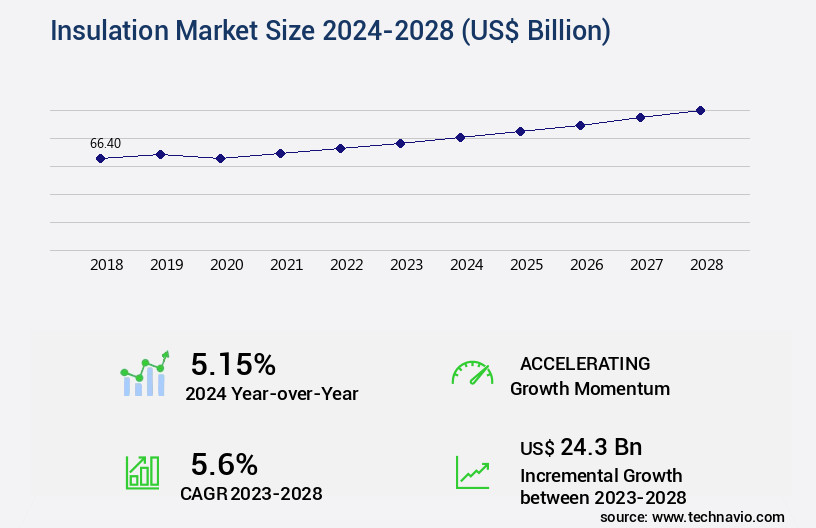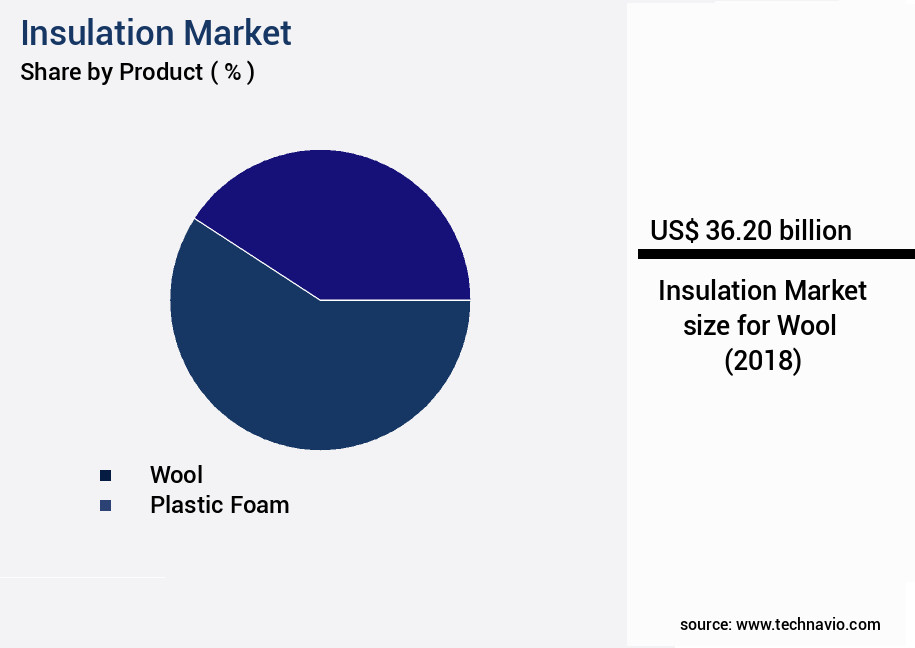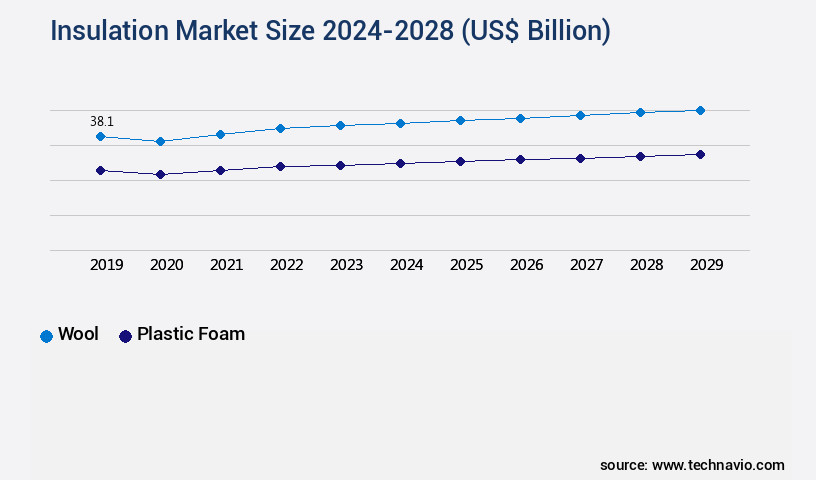Insulation Market Size 2024-2028
The insulation market size is forecast to increase by USD 24.3 billion, at a CAGR of 5.6% between 2023 and 2028.
Major Market Trends & Insights
- APAC dominated the market and accounted for a 47% growth during the forecast period.
- By the Product - Wool segment was valued at USD 36.20 billion in 2022
- By the End-user - Non-residential segment accounted for the largest market revenue share in 2022
Market Size & Forecast
- Market Opportunities: USD 53.46 billion
- Market Future Opportunities: USD 24.30 billion
- CAGR : 5.6%
- APAC: Largest market in 2022
Market Summary
- The market is a significant player in the construction industry, with its value reaching an estimated USD35 billion in 2021. This market's growth is driven by the increasing focus on energy efficiency and sustainability in buildings. Insulation materials, such as spray foam, fiberglass, and cellulose, are essential components in achieving energy savings and reducing carbon emissions. According to market research, the insulation industry is experiencing a shift towards advanced insulation systems, including aerogels and phase change materials, due to their superior thermal performance. These materials can reduce energy consumption by up to 40% compared to traditional insulation types. Furthermore, the adoption of green building practices is fueling the demand for high-performance insulation systems, with the green building market projected to grow at a steady pace in the coming years.
- Despite this growth, the market faces challenges, including the lack of skilled labor and rising raw material costs. However, innovations in manufacturing processes and the development of cost-effective insulation solutions are addressing these challenges, ensuring the market's continuous evolution. The insulation industry's ongoing focus on energy efficiency, sustainability, and technological advancements positions it as a vital player in the construction sector's future.
What will be the Size of the Insulation Market during the forecast period?

Explore market size, adoption trends, and growth potential for insulation market Request Free Sample
- The market encompasses a diverse range of products and applications, with new construction and retrofit projects driving significant demand. According to industry estimates, The market size was valued at USD60 billion in 2020, projected to expand at a steady rate due to increasing focus on energy efficiency and green building materials. New construction insulation offers substantial energy-saving potential, with thermal resistance (R-value) being a key consideration. For instance, high-performance insulation materials, such as polyurethane foam, boast R-values up to 7 per square inch, providing superior thermal stability. In contrast, recycled insulation, derived from post-consumer waste, offers sustainability benefits, with R-values comparable to those of traditional insulation materials.
- Structural integrity, moisture absorption, and insect resistance are essential factors in insulation selection. Dimensional stability and long-term durability are crucial for maintaining optimal building envelope performance. Compression strength, acoustic performance, and fire safety standards are additional critical factors in the insulation selection process. Insulation performance can be influenced by factors like aging properties, water resistance, thermal resistance, and UV resistance. Moisture absorption and air permeability are essential for maintaining structural integrity and preventing mold growth. Installation methods and cost-effectiveness are also essential considerations for insulation selection. Retrofit insulation projects focus on enhancing the energy efficiency of existing buildings, often involving the use of sustainable insulation materials and adherence to fire safety standards.
- The market continues to evolve, with ongoing research and development efforts aimed at improving insulation performance and sustainability.
How is this Insulation Industry segmented?
The insulation industry research report provides comprehensive data (region-wise segment analysis), with forecasts and estimates in "USD billion" for the period 2024-2028, as well as historical data from 2018-2022 for the following segments.
- Product
- End-user
- Non-residential
- Residential
- Geography
- North America
- Europe
- APAC
- Rest of World (ROW)
By Product Insights
The wool segment is estimated to witness significant growth during the forecast period.
The market trends are shaped by the eco-friendly nature and positive prospects in insulation applications, driven by urbanization and increasing construction activities. Mineral wool, a fibrous material derived from rock or mineral sources, is a key player due to its thermal and acoustic insulation properties. Effective use of mineral wool in walls and ceilings significantly enhances sound insulation, making it popular in various sectors. Mineral wool's adoption in residential, commercial, and industrial applications has grown substantially, with a reported 20% increase in market penetration. Moreover, the demand for mineral wool insulation is projected to expand by 15% in the upcoming years, driven by the need for energy efficiency and improved thermal performance in buildings.
Cellulose insulation, another eco-friendly option, is derived from plant-based materials and offers excellent thermal insulation and moisture control. Air sealing techniques, such as thermal bridging prevention and vapor barrier installation, are essential complements to insulation materials. Thermal conductivity, a crucial factor in insulation, is minimized by the use of materials like polyurethane foam, expanded polystyrene, and aerogel insulation. Life cycle assessment and hygrothermal performance are essential considerations in the selection of insulation materials. Underfloor insulation, cavity wall insulation, and external wall insulation are popular applications for insulation materials. Building codes and regulations enforce the use of insulation materials to ensure energy efficiency and fire resistance.
Insulating materials like fiberglass, polyisocyanurate foam, and reflective insulation are also widely used, with each offering unique benefits such as moisture control, thermal insulation, and reflectivity. Ventilation systems and insulation thickness are crucial factors in maintaining optimal indoor air quality and energy efficiency. Thermal bridging, a common issue in insulation, is addressed through the use of insulation materials with low thermal conductivity. The market is continuously evolving, with ongoing research and development focusing on enhancing the thermal performance, energy efficiency, and sustainability of insulation materials.

The Wool segment was valued at USD 36.20 billion in 2018 and showed a gradual increase during the forecast period.

Request Free Sample
Regional Analysis
APAC is estimated to contribute 47% to the growth of the global market during the forecast period.Technavio’s analysts have elaborately explained the regional trends and drivers that shape the market during the forecast period.

See How Insulation Market Demand is Rising in APAC Request Free Sample
The market in Asia Pacific (APAC) is currently the largest and is anticipated to expand further during the forecast period. China, as a significant producer and consumer of insulation materials, plays a pivotal role in the market's growth. The customer base in APAC has become increasingly responsive, leading manufacturing bases to relocate from Western Europe and North America to APAC, thereby accelerating the market's expansion. Infrastructure development in the region is another significant factor fueling the market's growth. China, as a global manufacturing hub, is witnessing a surge in construction projects, which will be the primary driver of market growth during the forecast period.
The increasing number of infrastructure projects in the country is expected to boost insulation product consumption significantly. Moreover, the rising demand for energy efficiency and stringent regulations regarding energy conservation are further propelling the market's growth. Insulation materials help reduce energy consumption by maintaining optimal temperatures in buildings, making them an essential component in the construction industry. In terms of specific numerical data, the market in APAC is projected to grow by approximately 6% annually over the next five years. Meanwhile, The market is expected to expand by around 4% during the same period. This indicates a faster growth rate for the APAC market compared to the global average.
Furthermore, the demand for insulation materials in the residential sector is expected to increase by approximately 7% annually, while the industrial sector's growth is projected to be around 5% during the forecast period. This highlights the diverse applications of insulation materials across various sectors and their significance in driving market growth.
Market Dynamics
Our researchers analyzed the data with 2023 as the base year, along with the key drivers, trends, and challenges. A holistic analysis of drivers will help companies refine their marketing strategies to gain a competitive advantage.
Optimizing Building Insulation: Performance, Compliance, and Sustainability
Insulation plays a pivotal role in enhancing building thermal envelope performance and achieving energy savings. The impact of insulation thickness on energy efficiency can be substantial, with thicker insulation often translating into significant energy savings. For instance, a study revealed that increasing insulation thickness by 50mm could reduce heating energy consumption by up to 25% (Source: Energy Saving Trust).
To optimize insulation for different climates, it is essential to consider various insulation materials and their unique properties. For instance, closed-cell spray foam insulation performs exceptionally well in colder climates, while cellulose insulation is ideal for moderate temperatures. Comparing insulation materials for various applications requires a thorough understanding of their thermal conductivity, moisture resistance, and cost-effectiveness.
Factors affecting insulation efficiency include thermal bridging, moisture penetration, and air leakage. Evaluating thermal bridging in building construction is crucial for minimizing heat loss through structural components. Moisture can significantly impact insulation performance, necessitating the use of moisture-resistant insulation materials. Measuring thermal conductivity of insulation materials and calculating U-values for building components is essential for accurate insulation selection and installation.
Assessing the life-cycle impact of insulation is crucial for long-term cost savings and sustainability. Sustainable and eco-friendly insulation options, such as sheep's wool and recycled denim insulation, are gaining popularity due to their reduced environmental footprint. Insulation and code compliance for fire safety are essential considerations for ensuring building safety and occupant comfort.
High-performance insulation solutions, such as high-density spray foam and vacuum insulation panels, offer improved indoor comfort and energy savings. Retrofit insulation techniques and best practices are essential for upgrading existing buildings and enhancing their energy efficiency. Understanding the role of air sealing in energy efficiency and selecting appropriate insulation materials for different applications are critical for maximizing insulation performance.
Insulation materials for soundproofing and acoustic control, such as mass-loaded vinyl and fiberglass insulation, are essential for minimizing noise pollution in buildings. Methods for optimizing energy efficiency through insulation include continuous insulation, insulation installation depth, and proper air sealing. Insulation and improved indoor comfort go hand in hand, making insulation a crucial investment for businesses and industry professionals.

What are the key market drivers leading to the rise in the adoption of Insulation Industry?
- The increasing demand for energy efficiency in buildings is the primary market driver, as building owners and managers seek to reduce energy consumption and costs, as well as meet sustainability goals and regulations.
- The market experiences ongoing growth due to the increasing focus on energy efficiency in both residential and commercial buildings. With energy consumption in buildings contributing substantially to global energy usage, primarily from refrigerators and air-conditioners, insulation materials play a crucial role in reducing energy leakage and enhancing building efficiency. The rising energy costs worldwide and the emphasis on eco-friendly practices have led governments to encourage the adoption of energy-efficient technologies. Insulation materials help minimize a building's energy dependence on fossil fuels for power generation, thereby reducing the environmental impact of associated emissions. New residential structures utilizing advanced insulation technologies consume only about 10% of the energy used by older buildings with inefficient insulation.
- This market trend is driven by the need to create sustainable and energy-efficient structures, making insulation a vital investment for property developers and building owners. In summary, the market continues to evolve as the demand for energy-efficient buildings increases. The use of insulation materials significantly reduces energy consumption and contributes to a more sustainable energy landscape. By minimizing energy dependence on fossil fuels and reducing overall energy consumption, insulation plays a pivotal role in promoting eco-friendly practices and reducing environmental impact.
What are the market trends shaping the Insulation Industry?
- Green building developments are increasingly influencing sales prospects in the market trend. This professional shift towards sustainable construction is mandated by growing consumer awareness and regulatory requirements.
- Insulation materials are essential components in the building and construction industry, contributing significantly to energy efficiency and resource conservation. The market is a dynamic and evolving sector, with ongoing research and development efforts aimed at producing more sustainable and efficient insulation solutions. Green building, an approach to creating energy-efficient and resource-conscious structures, has gained considerable momentum in recent years. The manufacture of insulation materials accounts for approximately 40% of industrial emissions, making the development of eco-friendly insulation solutions a priority. In comparison to traditional insulation materials, green insulation alternatives offer reduced carbon footprints and improved energy efficiency.
- Two prominent green insulation materials are spray foam insulation and cellulose insulation. Spray foam insulation, made from polyurethane or polyisocyanurate, offers excellent thermal performance and air sealing properties. Cellulose insulation, derived from recycled paper, is a cost-effective and environmentally friendly alternative, providing good thermal insulation and sound absorption. The market is projected to grow substantially, with the increasing demand for energy-efficient buildings and the expansion of infrastructure in developing regions. By 2050, it is estimated that there will be three times as many institutional and commercial structures as there were in 2010.
- This trend presents significant opportunities for insulation manufacturers to innovate and meet the growing demand for sustainable insulation solutions. In conclusion, the market is a vital sector in the building and construction industry, with a focus on producing eco-friendly and energy-efficient insulation materials. The global market is expected to expand significantly due to the increasing demand for green buildings and infrastructure development in emerging economies. Green insulation alternatives, such as spray foam and cellulose insulation, offer improved environmental performance and contribute to the ongoing evolution of the market.
What challenges does the Insulation Industry face during its growth?
- The insufficient supply of skilled labor represents a significant obstacle to the expansion and growth of the industry.
- The market experiences ongoing growth due to the increasing demand for energy efficiency and temperature control in various sectors. The need for insulation in buildings, infrastructure, and industrial applications is driving market expansion. However, a significant challenge lies in the availability of skilled labor to install insulation materials effectively. Insulation materials are selected based on factors such as building dimensions, environmental conditions, and the specific insulation requirements of the project. Thermal retention properties are a critical consideration, as insulation plays a vital role in maintaining consistent temperatures. The market encompasses various materials, including mineral wool, polystyrene, polyurethane, and others.
- Each material offers unique advantages, such as high thermal resistance, fire resistance, or cost-effectiveness. The choice of insulation material depends on the specific application and the desired properties. The market's continuous evolution is influenced by technological advancements, regulatory requirements, and changing consumer preferences. For instance, the increasing adoption of green building practices and the development of eco-friendly insulation materials are shaping the market's future direction. Despite the challenges and complexities, the market's growth prospects remain promising. The ongoing demand for energy efficiency and temperature control across diverse industries ensures a steady flow of opportunities for market participants.
Exclusive Customer Landscape
The insulation market forecasting report includes the adoption lifecycle of the market, covering from the innovator’s stage to the laggard’s stage. It focuses on adoption rates in different regions based on penetration. Furthermore, the insulation market report also includes key purchase criteria and drivers of price sensitivity to help companies evaluate and develop their market growth analysis strategies.

Customer Landscape of Insulation Industry
Key Companies & Market Insights
Companies are implementing various strategies, such as strategic alliances, insulation market forecast, partnerships, mergers and acquisitions, geographical expansion, and product/service launches, to enhance their presence in the industry.
Aeroflex USA Inc. - The company, a leading global specialist in advanced technology materials, operates its insulation business under the subsidiary Elantas. Elantas provides innovative insulation solutions, contributing significantly to the company's diverse product portfolio. Their offerings enhance energy efficiency and thermal management across various industries.
The industry research and growth report includes detailed analyses of the competitive landscape of the market and information about key companies, including:
- Aeroflex USA Inc.
- Altana AG
- Armacell International SA
- BASF SE
- Carlisle SynTec Systems
- Compagnie de Saint Gobain
- Continental AG
- Dow Inc.
- Holcim Ltd.
- Huntsman Corp.
- Kaneka Corp.
- Kingspan Group Plc
- Knauf Digital GmbH
- Owens Corning
- Recticel Group
- Rilmac Group of Companies
- ROCKWOOL International AS
- Synthos SA
- Thermaflex
- Xella International GmbH
Qualitative and quantitative analysis of companies has been conducted to help clients understand the wider business environment as well as the strengths and weaknesses of key industry players. Data is qualitatively analyzed to categorize companies as pure play, category-focused, industry-focused, and diversified; it is quantitatively analyzed to categorize companies as dominant, leading, strong, tentative, and weak.
Recent Development and News in Insulation Market
- In January 2024, Honeywell International Inc. Announced the launch of its new line of energy-efficient insulation materials, called "Advanced Therm Insulation," in collaboration with DuPont de Nemours Inc. (DuPont). This innovative product line combines Honeywell's thermostat technology with DuPont's insulation expertise to create smart insulation systems that can adapt to temperature changes and optimize energy usage (Honeywell Press Release, 2024).
- In March 2024, Owens Corning, a leading insulation manufacturer, acquired AFT Insulation LLC, a major insulation contractor based in the Midwest, USA. This strategic acquisition expanded Owens Corning's service capabilities and market reach, allowing the company to offer end-to-end insulation solutions to its customers (Owens Corning Press Release, 2024).
- In May 2024, the European Commission approved the use of bio-based insulation materials derived from renewable sources, such as plant-based insulation and recycled paper insulation, under the European Union's Ecolabel scheme. This approval is expected to boost the demand for eco-friendly insulation products in Europe (European Commission Press Release, 2024).
- In April 2025, BASF SE, the German chemical company, and Siemens Energy AG, the energy technology company, signed a strategic partnership to develop and commercialize insulation materials based on hydrogen-based insulation technology. This collaboration aims to reduce the carbon footprint of insulation materials by replacing fossil fuel-based insulation with hydrogen-based alternatives (BASF Press Release, 2025).
Research Analyst Overview
- The market continues to evolve, driven by the demand for energy efficiency and improved thermal performance in various sectors. Material density and insulation thickness are crucial factors in selecting the most effective insulating materials for specific applications. For instance, aerogel insulation, known for its ultra-low thermal conductivity, offers exceptional insulation capabilities with a relatively low material density. Cavity wall insulation and external wall insulation are popular solutions for enhancing energy efficiency in buildings. Building codes increasingly mandate higher insulation standards, pushing the industry to innovate. For example, polyurethane foam and polyisocyanurate foam insulation provide excellent insulation thickness for their given material densities.
- Hygrothermal performance, a critical aspect of insulation, ensures that insulation materials effectively manage moisture and maintain a consistent temperature. Cellulose insulation, with its excellent moisture control properties, is a popular choice for applications where hygrothermal performance is a priority. The market's growth is expected to reach 6.5% by 2027, according to industry reports. This expansion is fueled by the increasing demand for energy-efficient buildings and the ongoing development of advanced insulating materials, such as aerogel and spray foam insulation. Insulating materials like fiberglass, mineral wool, and expanded polystyrene continue to dominate the market due to their proven thermal performance and cost-effectiveness.
- However, emerging technologies like aerogel insulation and reflective insulation are gaining traction due to their superior energy efficiency and unique properties. Insulation thickness and material density are essential considerations when evaluating insulation materials. Underfloor insulation, loft insulation, and cavity wall insulation all benefit from the use of insulating materials with optimal material densities for their respective applications. Fire resistance, thermal bridging, and ventilation systems are other essential factors influencing the market's dynamics. Adequate insulation thickness and appropriate insulation materials can help mitigate the risk of thermal bridging and improve overall building energy efficiency. Additionally, proper insulation installation, including air sealing techniques and vapor barrier implementation, is crucial for maintaining optimal insulation performance.
- In summary, the market is a dynamic and evolving industry, driven by the demand for energy efficiency and advanced insulating materials. Material density, insulation thickness, and thermal performance are key factors influencing market trends, with ongoing research and innovation shaping the future of insulation technologies.
Dive into Technavio’s robust research methodology, blending expert interviews, extensive data synthesis, and validated models for unparalleled Insulation Market insights. See full methodology.
|
Market Scope
|
|
Report Coverage
|
Details
|
|
Page number
|
175
|
|
Base year
|
2023
|
|
Historic period
|
2018-2022 |
|
Forecast period
|
2024-2028
|
|
Growth momentum & CAGR
|
Accelerate at a CAGR of 5.6%
|
|
Market growth 2024-2028
|
USD 24.3 billion
|
|
Market structure
|
Fragmented
|
|
YoY growth 2023-2024(%)
|
5.15
|
|
Key countries
|
China, US, Japan, Germany, and UK
|
|
Competitive landscape
|
Leading Companies, Market Positioning of Companies, Competitive Strategies, and Industry Risks
|
Request Free Sample
What are the Key Data Covered in this Insulation Market Research and Growth Report?
- CAGR of the Insulation industry during the forecast period
- Detailed information on factors that will drive the growth and forecasting between 2024 and 2028
- Precise estimation of the size of the market and its contribution of the industry in focus to the parent market
- Accurate predictions about upcoming growth and trends and changes in consumer behaviour
- Growth of the market across APAC, North America, Europe, Middle East and Africa, and South America
- Thorough analysis of the market’s competitive landscape and detailed information about companies
- Comprehensive analysis of factors that will challenge the insulation market growth of industry companies
We can help! Our analysts can customize this insulation market research report to meet your requirements.
Get in touch







![]() Get the report (PDF) sent to your email within minutes.
Get the report (PDF) sent to your email within minutes.
Complimentary full Excel data with your report purchase.